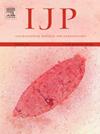Mortality associated with Angiostrongylus cantonensis in non-human primates in Europe
IF 3.2
2区 医学
Q1 PARASITOLOGY
引用次数: 0
Abstract
Between December 2020 and March 2022, three cases of fatal meningoencephalitis were documented in two red-fronted brown lemurs (Eulemur rufus) and a ring-tailed lemur (Lemur catta) at the Bioparc in Valencia, eastern Spain. Post-mortem analyses revealed moderate congestion in the meninges of the brain in all cases. Multifocal areas of hemorrhage were observed in one lemur, primarily in the cerebellum and brainstem. Histopathological examination showed mainly acute hemorrhagic and necrotic changes, together with moderate eosinophilic and/or histiocytic meningoencephalitis, with perivascular cuffing, and gliosis. Numerous nematode larvae were found in the meninges, brain, and spinal cord, with or without associated inflammation, hemorrhage, and necrosis. Considering the affected host species, nematode morphology, and its anatomical localization, Angiostrongylus cantonensis (Nematoda: Metastrongylidae) was suspected as the causative agent. Phylogenetic studies based on the internal transcriber spacer 1/cytochrome c oxidase subunit I (ITS1/COI) genes confirmed the initial suspicion of this zoonotic parasite and its relationship to sequences from the Balearic and Canary Islands. This is the first known detection of A. cantonensis in non-human primates in Europe and it represents one of the few occurrences reported in the Palearctic region to date. Further research on this zoonotic parasite is crucial to understanding its spread in Spain, assessing public health risks, and developing effective control measures to mitigate outbreaks and protect human and animal health.

欧洲非人灵长类动物中与广东管圆线虫有关的死亡率。
在2020年12月至2022年3月期间,在西班牙东部瓦伦西亚的Bioparc,两只红额棕色狐猴(Eulemur rufus)和一只环尾狐猴(lemur catta)中记录了三例致命的脑膜脑炎病例。尸检分析显示,所有病例的脑膜都有中度充血。在一只狐猴中观察到多灶性出血,主要发生在小脑和脑干。组织病理学检查主要显示急性出血和坏死改变,同时伴有中度嗜酸性粒细胞和/或组织细胞性脑膜脑炎,伴血管周围弯曲和胶质瘤。在脑膜、脑和脊髓中发现大量线虫幼虫,伴有或不伴有炎症、出血和坏死。考虑到受感染的寄主种类、线虫形态及其解剖定位,怀疑广东管圆线虫(nematda: metta圆线虫科)为病原体。基于内部转录间隔子1/细胞色素c氧化酶亚基I (ITS1/COI)基因的系统发育研究证实了这种人畜共患寄生虫的初步怀疑及其与巴利阿里群岛和加那利群岛序列的关系。这是欧洲首次在非人灵长类动物中发现广东古猿,也是迄今为止在古北极地区报告的少数病例之一。对这种人畜共患寄生虫的进一步研究对于了解其在西班牙的传播情况、评估公共卫生风险以及制定有效的控制措施以减轻疫情并保护人类和动物健康至关重要。
本文章由计算机程序翻译,如有差异,请以英文原文为准。
求助全文
约1分钟内获得全文
求助全文
来源期刊
CiteScore
8.40
自引率
2.50%
发文量
76
审稿时长
23 days
期刊介绍:
International Journal for Parasitology offers authors the option to sponsor nonsubscriber access to their articles on Elsevier electronic publishing platforms. For more information please view our Sponsored Articles page. The International Journal for Parasitology publishes the results of original research in all aspects of basic and applied parasitology, including all the fields covered by its Specialist Editors, and ranging from parasites and host-parasite relationships of intrinsic biological interest to those of social and economic importance in human and veterinary medicine and agriculture.

 求助内容:
求助内容: 应助结果提醒方式:
应助结果提醒方式:


